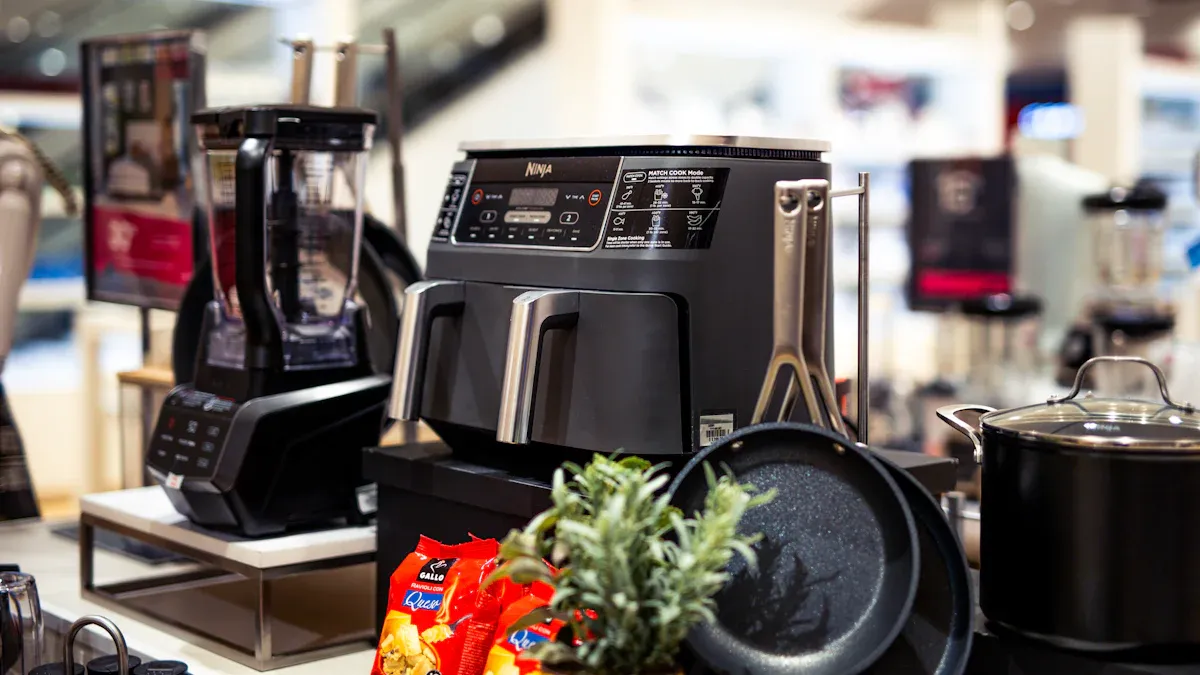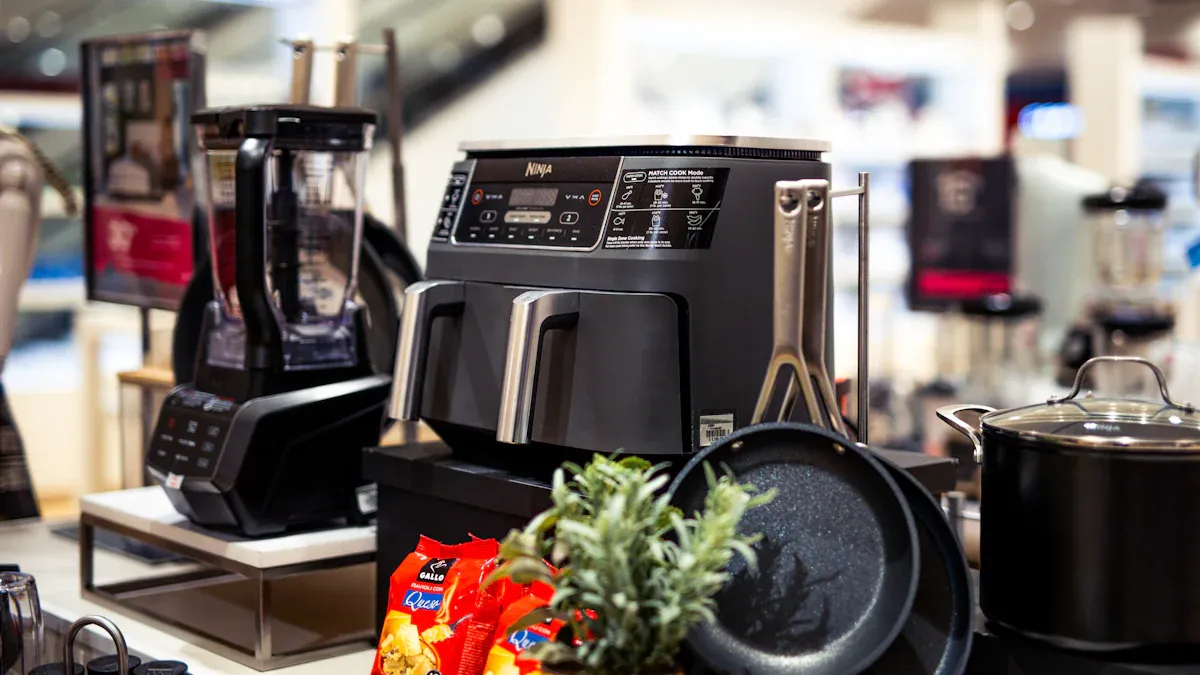
The Household Mechanical Control Air Fryer transforms cooking into a healthier and simpler experience. This Electric Heating Air Fryer uses little to no oil, making it a preferred choice for health-conscious individuals. With its innovative design, this appliance falls under the category of Household Visible Air Fryers, ensuring you can monitor your food as it cooks. The Double Heating Element Air Fryer guarantees crispy, delicious meals with ease. Its straightforward operation and compact size make it ideal for any kitchen or dorm room.
Understanding the Household Mechanical Control Air Fryer

How It Works
The Household Mechanical Control Air Fryer uses advanced technology to cook food efficiently and healthily. Its operation involves three key steps:
- The heating element warms the air inside the fryer.
- A powerful fan circulates the hot air evenly around the food.
- Rapid air movement triggers the Maillard reaction, creating a crispy texture on the outside while keeping the inside tender.
This process eliminates the need for excessive oil, making it a healthier alternative to traditional frying methods. The mechanical controls allow users to set the time and temperature with precision, ensuring consistent results every time.
Key Features and Advantages
The Household Mechanical Control Air Fryer offers several features that enhance its usability and performance. The table below highlights its key advantages:
| Feature/Advantage | Description |
|---|---|
| Easy Operation | Simple to operate with mechanical design and separate controls. |
| High Efficiency | 360-degree high-speed air circulation for rapid cooking. |
| Health Benefits | Reduces fat content in cooking by up to 80%. |
| Easy to Clean | Non-stick cooking surface and food-grade material for safety. |
| Automatic Shutdown System | Provides safety during operation. |
| Visible Window Effect | Allows monitoring of cooking progress. |
| Affordable | Generally inexpensive, suitable for students and novice cooks. |
These features make the air fryer a practical and reliable choice for everyday cooking.
Why Choose a Mechanical Control Air Fryer?
The Household Mechanical Control Air Fryer stands out for its simplicity and effectiveness. Its mechanical design appeals to those who prefer straightforward controls without the complexity of digital interfaces. The compact size makes it ideal for small kitchens or dorm rooms, while its affordability ensures accessibility for a wide range of users. Additionally, the ability to cook with less oil supports healthier eating habits, making it a valuable addition to any kitchen.
Essential Tips for Optimal Use
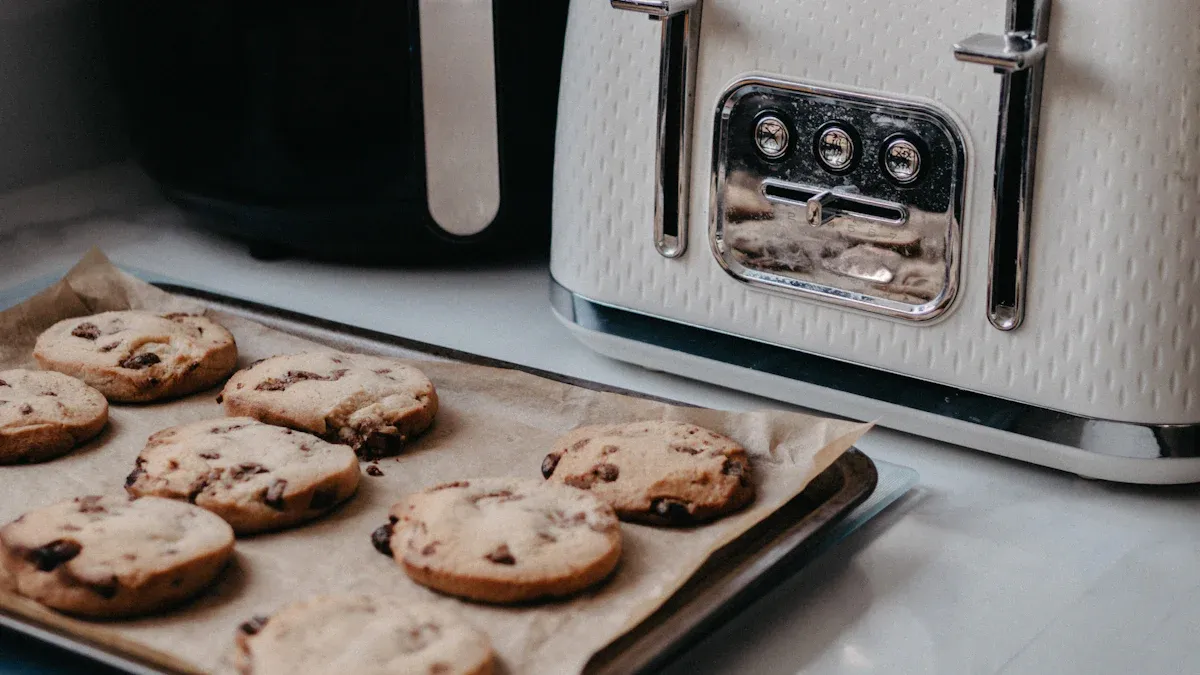
Preheating for Better Results
Preheating the Household Mechanical Control Air Fryer ensures consistent cooking results. When the air fryer reaches the desired temperature before cooking begins, it stabilizes the internal heat. This stability prevents temperature fluctuations, which can lead to uneven cooking or longer preparation times. Preheating also allows the air fryer to deliver more energy to the food, resulting in crispier textures and better flavors. For optimal results, preheat the air fryer for 3-5 minutes before adding ingredients.
Avoiding Overcrowding
Overcrowding the air fryer basket can hinder airflow, leading to uneven cooking. To achieve the best results, arrange food in a single layer with enough space for air to circulate. For larger meals, cook in batches to maintain the air fryer’s efficiency. This approach ensures that every piece of food cooks evenly and achieves the desired crispiness.
Using Oil the Right Way
Using oil sparingly enhances the flavor and texture of food without compromising health benefits. Studies show that air frying produces significantly lower particulate matter compared to traditional frying methods. For example:
- Air frying emits only 0.6 micrograms of particulate matter per cubic meter, compared to 92.9 micrograms from pan frying.
- Less oil usage also reduces volatile organic compound (VOC) emissions, making air frying a cleaner cooking method.
A light spray of oil on the food surface is sufficient to achieve a golden, crispy finish.
Adjusting Time and Temperature
Adjusting time and temperature settings is crucial for maximizing the air fryer’s performance. Different foods require specific settings to cook properly. The table below provides a quick reference for common items:
| Food Item | Cooking Time (min) | Temperature (°F) |
|---|---|---|
| Frozen fries | 11 – 25 | 350 |
| Homemade fries | 12 – 25 | 350 |
| Potato wedges | 15 – 27 | 350 |
| Frozen snacks | 6 – 10 | 350 |
| Pork chops | 8 – 14 | 400 |
| Hamburger patties | 7 – 14 | 325 |
| Sausages | 3 – 15 | 325 |
| Drumsticks | 15 – 22 | 350 |
| Chicken breast | 10 – 15 | 350 |

Experimenting with these settings allows users to customize their cooking experience and achieve perfect results every time.
Versatile Cooking Ideas
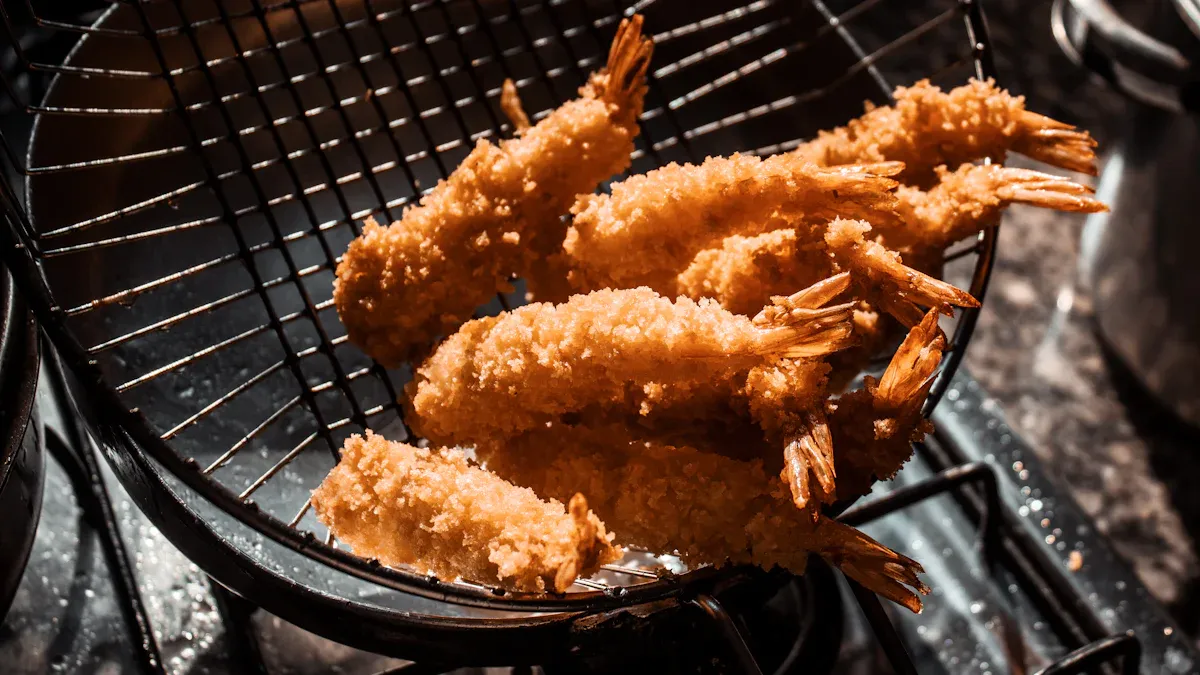
Crispy Favorites: Fries, Wings, and Veggies
The Household Mechanical Control Air Fryer excels at creating crispy textures for popular snacks. Fries achieve the perfect balance of fluffiness and crunch due to a 45% moisture loss during cooking. Wings turn out tender and evenly browned, especially when placed on the top shelf. Vegetables like zucchini and broccoli gain a delightful crispness without losing their natural flavors. Cooking at 360°F enhances these results, but adjusting the temperature based on food type can further improve texture.
Many users rely on air fryers for these dishes. Chips are prepared by 73% of users, while 48% use them for potatoes and 47% for breaded chicken. This versatility makes the air fryer a favorite for quick, delicious snacks.
Baking Made Easy: Cakes and Muffins
Baking in an air fryer simplifies the process while delivering excellent results. Preheating the appliance ensures even heat distribution, which is crucial for recipes using baking powder. Adjusting traditional oven recipes by lowering the temperature by 25 degrees and reducing the cooking time by 20% helps achieve optimal outcomes. Using air fryer-sized bakeware, such as muffin pans or small cake pans, maximizes efficiency.
Beginners can start with simple recipes like frozen cookie dough or biscuits to familiarize themselves with the appliance. Checking the progress at 30% of the cooking time allows adjustments for different air fryer models. These steps make baking cakes and muffins a breeze.
Grilling and Roasting: Meat and Fish
The air fryer’s high-speed air circulation system ensures even cooking for meat and fish. Sausages and chicken cook evenly, with 44% of users favoring these options. Breaded fish retains its crispness, while unbreaded varieties maintain their natural moisture. Beef burgers and bacon are also popular choices, with 24% of users preparing them in air fryers.
For best results, arrange food in a single layer to allow hot air to circulate freely. This method ensures that meat and fish are cooked thoroughly while retaining their juiciness and flavor.
Reheating with Perfect Texture
Reheating leftovers in the air fryer restores their original texture better than microwaves. Hot air circulation keeps food crispy and flavorful, making it ideal for items like pizza, fries, and chicken. This method preserves the quality of the food, ensuring it tastes as good as when it was first cooked.
Many users prefer air fryers for reheating because they maintain the food’s integrity without drying it out. This feature adds to the appliance’s versatility, making it a valuable tool for everyday cooking.
Maintenance and Cleaning Tips
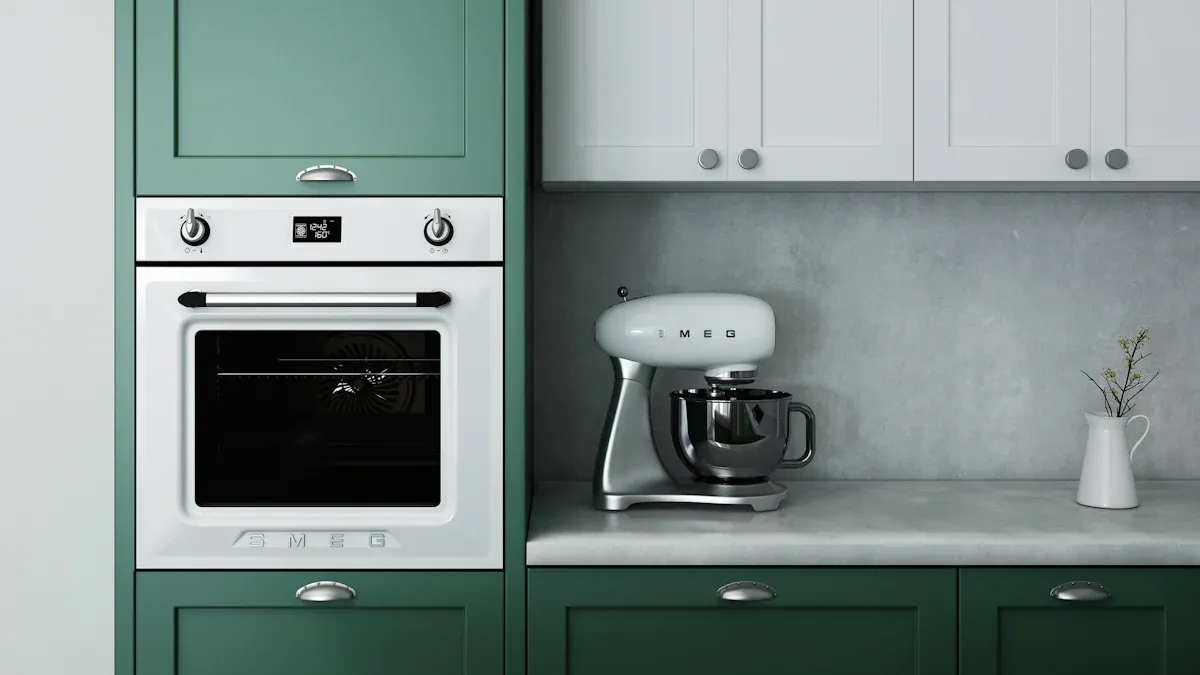
Cleaning the Basket and Tray
Cleaning the basket and tray after each use ensures optimal performance and extends the air fryer’s lifespan. Food particles left behind can stick to the surface, slowing down heating and increasing energy consumption. To clean effectively:
- Knock out loose crumbs and oil from the basket.
- Wipe the surface with a paper towel to remove residue.
- For stubborn messes, soak the basket in warm, soapy water before scrubbing gently with a non-abrasive sponge.
Avoid abrasive tools that may damage the nonstick coating. After cleaning, let the components dry completely before reassembling.
Removing Grease and Odors
Grease buildup and lingering odors can affect cooking outcomes and food safety. Regular cleaning prevents cross-contamination and ensures thorough cooking. To remove grease:
- Wipe the interior and heating chamber with a warm, damp cloth after the air fryer cools.
- Use a mild detergent to clean greasy surfaces, but avoid harsh chemicals.
For odors, place a bowl of vinegar or lemon juice inside the air fryer and run it at a low temperature for a few minutes. This method neutralizes smells and keeps the appliance fresh.
Regular Maintenance for Longevity
Proper maintenance keeps the air fryer functioning efficiently over time. Follow these steps:
- Unplug the appliance before cleaning to ensure safety.
- Allow it to cool completely before handling.
- Clean the basket and tray with warm, soapy water after every use.
- Wipe the heating element weekly to prevent grease buildup.
- Consult the manufacturer’s instructions for specific care guidelines.
Safe Storage Practices
Storing the air fryer correctly protects it from damage and ensures readiness for future use. Keep the appliance in a dry, cool place away from direct sunlight. Wrap the cord neatly to prevent tangling or fraying. If possible, store the air fryer with its basket and tray detached to allow airflow and prevent odors. Regularly inspect the cord and components for wear and tear to maintain safety and functionality.
Common Mistakes to Avoid
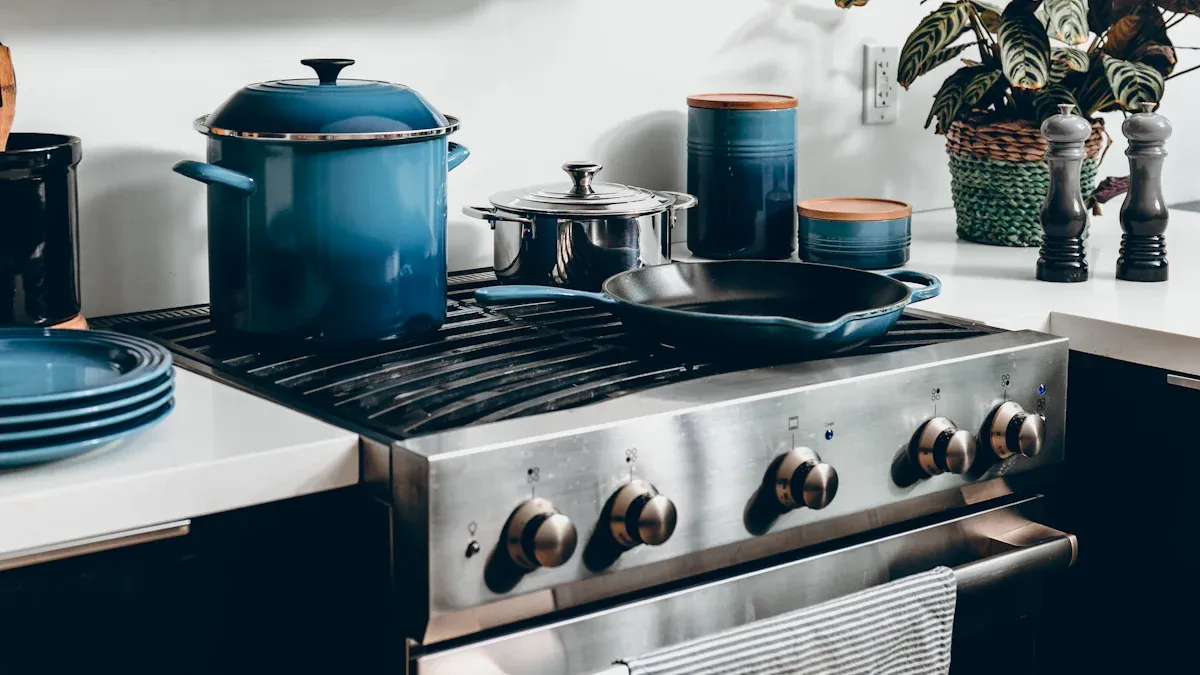
Overloading the Basket
Overloading the air fryer basket is a common mistake that can negatively impact cooking results. Proper air circulation is essential for even cooking, but overcrowding blocks the flow of hot air. This leads to unevenly cooked food and longer cooking times.
- Overcrowding the basket can impede air circulation.
- Uneven cooking results often occur due to improper spacing.
- Cooking times increase when the basket is overloaded.
To avoid this issue, arrange food in a single layer and leave enough space between items. For larger meals, cooking in batches ensures better results and maintains the air fryer’s efficiency.
Misusing Oil
Using oil incorrectly can affect both the taste and health benefits of air-fried food. While air fryers require minimal oil, applying too much can cause food to become greasy. On the other hand, skipping oil entirely may result in dry or uneven textures.
A light spray of oil on the food surface enhances crispiness without compromising health. However, failing to clean the air fryer after using oil can lead to grease buildup. This not only affects performance but also increases the risk of foodborne illnesses. Regular cleaning ensures safe and efficient operation.
Skipping Regular Cleaning
Neglecting to clean the air fryer after each use can lead to several problems. Residual food particles and grease can hinder performance and pose safety risks.
- Accumulated grease can cause uneven cooking and undercooked food.
- Food particles left behind may trigger allergic reactions or cross-contamination.
- Excess grease and debris can ignite, causing smoke or even a fire.
To maintain optimal performance, clean the basket and tray thoroughly after every use. Wiping the interior and heating element weekly prevents grease buildup and ensures safe operation.
Ignoring Instructions
Ignoring the manufacturer’s instructions can result in improper use of the air fryer. Each model has specific guidelines for time, temperature, and maintenance. Failing to follow these instructions may lead to subpar results or even damage the appliance.
Always refer to the user manual for recommended settings and care tips. Understanding the air fryer’s features and limitations ensures a better cooking experience and prolongs its lifespan.
The Household Mechanical Control Air Fryer offers numerous benefits for healthier and more efficient cooking. Its ability to reduce fat content, lower calorie intake, and minimize harmful compounds makes it a valuable tool for health-conscious individuals. Users can explore its versatility by frying, roasting, baking, or grilling their favorite dishes. Proper maintenance, such as regular cleaning and safe storage, ensures long-term performance and reliability.
With its convenience and multifunctionality, this air fryer simplifies meal preparation while promoting healthier eating habits.
FAQ
How much oil should be used in the air fryer?
A light spray or one teaspoon of oil is enough. This enhances crispiness while maintaining the health benefits of air frying.
Can aluminum foil be used in the air fryer?
Yes, aluminum foil can be used. Ensure it doesn’t block airflow and avoid covering the basket entirely for even cooking.
What foods should not be cooked in the air fryer?
Foods with wet batter, like tempura, should be avoided. The batter may drip and create uneven cooking or mess inside the appliance.

